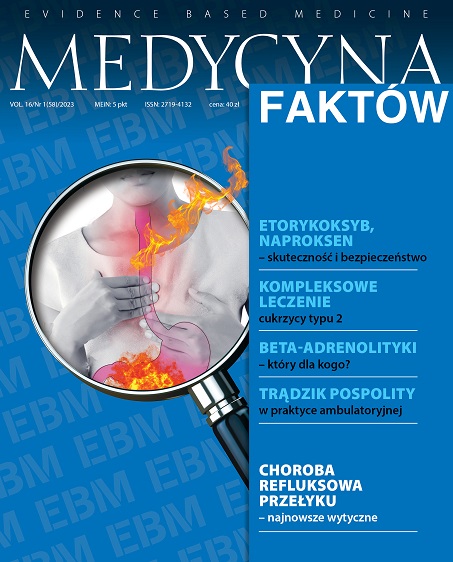Efficacy of calcium dobesylate in the treatment of chronic venous insufficiency Review article
Main Article Content
Abstract
Chronic venous insufficiency is a set of symptoms resulting from long-term venous dilatation and the associated increase in venous pressure. The therapy includes conservative, minimally invasive, surgical methods or is a combination of methods mentioned above. Conservative treatment is based on compression therapy and supportive measures such as physiotherapy, manual lymphatic drainage and the use of phlebotonics. Due to the low percentage of patients who accept compression therapy, phlebotonic drugs play an important role in eliminating the symptoms of venous insufficiency. Calcium dobesilate belongs to a group of drugs that protect the vascular walls. Its distinguishing feature in this group is its significant effect on blood rheological parameters, which makes it an extremely valuable specimen in the treatment of chronic venous insufficiency in patients with comorbidities and factors causing an increase in blood viscosity.
Article Details
Copyright © by Medical Education. All rights reserved.
References
2. Zubilewicz R, Jaroszyński A. Przewlekła choroba żylna. Forum Medycyny Rodzinnej. 2015; 9(5): 400-4.
3. Santler B, Goerge T. Chronic venous insufficiency – a review of pathophysiology, diagnosis, and treatment. JDDG. 2017; 15(5): 538-56.
4. Simka M, Majewski E. The social and economic burden of venous leg ulcers. Focus on the role of micronized purified flavonoid fraction adjuvant therapy. Am J Clin Dermatol. 2003; 4(8): 573-81.
5. Kasperczak J, Ropacka-Lesiak M, Bręborowicz GH. Definicja, podział oraz diagnostyka przewlekłej niewydolności żylnej – część II. Ginekol Pol. 2013; 84: 51-5.
6. Hamdan A. Management of varicose veins and venous insufficiency. JAMA. 2012; 308(24): 2612-21.
7. Youn JY, Lee J. Chronic venous insufficiency and varicose veins of the lower extremities. Korean J Intern Med. 2019; 34(2): 269-83.
8. Chudek J, Ziaja D. Farmakoterapia przewlekłej choroby żylnej w świetle medycyny opartej na faktach. Chirurgia Polska. 2013; 15(1): 58-65.
9. Lesner K, Reich A. Dobezylan wapnia – nowe zastosowania. Forum Dermatologicum. 2016; 2(4): 134-8.
10. Ciapponi A, Laffaire E, Roqué M. Calcium dobesilate for chronic venous insufficiency: A systematic review. Angiology. 2004; 55(2): 147-54.
11. Allain H, Ramelet AA, Polard E et al. Safety of Calcium dobesilate in chronic venous disease, diabetic retinopathy and haemorrhoids. Drug Safety. 2004; 27(9): 649-60.
12. Ramelet AA. Venoactive drugs. In: Goldman MP, Guex JJ, Weiss RA. Sclerotherapy: treatment of varicose and telangiectatic leg veins. 5th ed. Elsevier Saunders, Philadelphia, PA 2011: 369-77.
13. Kaur C, Sarkar R, Kanwar AJ et al. An open trial of calcium dobesilate in patients with venous ulcers and stasis dermatitis. Int J Dermatol. 2003; 42: 147-52.
14. Rabe E, Jaeger KA, Bulitta M et al. Calcium dobesilate in patients suffering from chronic venous insufficiency: a double-blind, placebo-controlled, clinical trial. Phlebology. 2011; 26: 162-8.
15. Chudek J. Raport końcowy z badania obserwacyjnego, wieloośrodkowego, w rozumieniu przepisów art. 37 al. Prawo farmaceutyczne: Ocena skuteczności stosowania produktu leczniczego Dobenox Forte® u pacjentów z objawami przewlekłej niewydolności krążenia żylnego, żylakami kończyn dolnych i żylakami odbytu (Has/Dob/2016/006). 2017.
16. Költringer P, Eber O, Rothlauer W. Calcium dobesilate and its effects on hemorheology and microcirculation. Int J Clin Pharmacol Ther Toxicol. 1988; 26(10): 500-2.
17. Dobenox Forte. Charakterystyka produktu leczniczego.
18. Garbe E. Non-chemotherapy drug-induced agranulocytosis. Expert Opin Drug Saf. 2007; 6(3): 323-35.
19. Rajzer M, Palka I, Kawecka-Jaszcz K. Znaczenie zjawiska lepkości krwi w patogenezie nadciśnienia tętniczego. Nadciśnienie Tętnicze. 2007; 11(1): 1-11.
20. Cekirdekci EI, Bugan B. Whole blood viscosity in microvascular angina and coronary artery disease: significance and utility. Rev Port Cardiol (Engl Ed). 2020; 39(1): 17-23.
21. Lowe GD, Drummond MM, Forbes CD et al. Increased blood viscosity in young women using oral contraceptives. Am J Obstet Gynecol. 1980; 137(7): 840-2.
22. Guiraudou M, Varlet-Marie E, Raynaud de Mauverger E et al. Obesity-related increase in whole blood viscosity includes different profiles according to fat localization. Clin Hemorheol Microcirc. 2013; 55(1): 63-73.
23. Carallo C, Irace C, De Franceschi MS et al. The effect of aging on blood and plasma viscosity. An 11.6 years follow-up study. Clin Hemorheol Microcirc. 2011; 47(1): 67-74.
24. Bonithon-Kopp C, Scarabin PY, Malmejac A. Menopause-related change in plasma viscosity. Clin Hemorheol Microcirc. 2016; 8(34): 525-31.

